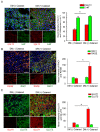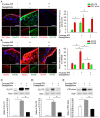Dapagliflozin Prevents NOX- and SGLT2-Dependent Oxidative Stress in Lens Cells Exposed to Fructose-Induced Diabetes Mellitus
- PMID: 31491943
- PMCID: PMC6770809
- DOI: 10.3390/ijms20184357
Dapagliflozin Prevents NOX- and SGLT2-Dependent Oxidative Stress in Lens Cells Exposed to Fructose-Induced Diabetes Mellitus
Abstract
Purpose: Cataracts in patients with diabetes mellitus (DM) are a major cause of blindness in developed and developing countries. This study aims to examine whether the generation of reactive oxygen species (ROS) via the increased expression of glucose transporters (GLUTs) and the receptor for advanced glycation end products (RAGE) influences the cataract development in DM.
Methods: Lens epithelial cells (LECs) were isolated during cataract surgery from patients without DM or with DM, but without diabetic retinopathy. In a rat model, fructose (10% fructose, 8 or 12 weeks) with or without dapagliflozin (1.2 mg/day, 2 weeks) treatment did induce DM, as verified by blood pressure and serum parameter measurements. Immunofluorescence stainings and immunoblottings were used to quantify the protein levels. Endogenous O2˙¯ production in the LECs was determined in vivo with dihydroethidium stainings.
Results: We investigated that GLUT levels in LECs differed significantly, thus leading to the direct enhancement of RAGE-associated superoxide generation in DM patients with cataracts. Superoxide production was significantly higher in LECs from rats with fructose-induced type 2 DM, whereas treatment with the sodium-glucose cotransporter 2 (SGLT2) inhibitor dapagliflozin prevented this effect in fructose-fed rats. Protein expression levels of the sodium/glucose cotransporter 2 (SGLT2), GLUT1, GLUT5, the nicotinamide adenine dinucleotide phosphate reduced form (NADPH) oxidase subunit p67-phox, NOX2/4 and RAGE were upregulated in fructose-fed animals, whereas dapagliflozin treatment reversed these effects.
Conclusions: In rats with fructose-induced DM, dapagliflozin downregulates RAGE-induced NADPH oxidase expression in LECs via the inactivation of GLUTs and a reduction in ROS generation. These novel findings suggest that the SGLT2 inhibitor dapagliflozin may be a candidate for the pharmacological prevention of cataracts in patients with DM.
Keywords: NADPH oxidase; cataract; dapagliflozin; glucose transporter; type 2 diabetes mellitus.
Conflict of interest statement
The authors of this study declared no conflicts of interest.
Figures





Similar articles
-
Blocking of SGLT2 to Eliminate NADPH-Induced Oxidative Stress in Lenses of Animals with Fructose-Induced Diabetes Mellitus.Int J Mol Sci. 2022 Jun 27;23(13):7142. doi: 10.3390/ijms23137142. Int J Mol Sci. 2022. PMID: 35806147 Free PMC article.
-
Attenuation of epithelial-mesenchymal transition via SGLT2 inhibition and diabetic cataract suppression by dapagliflozin nanoparticles treatment.Life Sci. 2023 Oct 1;330:122005. doi: 10.1016/j.lfs.2023.122005. Epub 2023 Aug 6. Life Sci. 2023. PMID: 37549827
-
3H-1,2-Dithiole-3-Thione Protects Lens Epithelial Cells against Fructose-Induced Epithelial-Mesenchymal Transition via Activation of AMPK to Eliminate AKR1B1-Induced Oxidative Stress in Diabetes Mellitus.Antioxidants (Basel). 2021 Jul 6;10(7):1086. doi: 10.3390/antiox10071086. Antioxidants (Basel). 2021. PMID: 34356319 Free PMC article.
-
Nicotinamide Adenine Dinucleotide Phosphate Oxidases in Glucose Homeostasis and Diabetes-Related Endothelial Cell Dysfunction.Cells. 2021 Sep 4;10(9):2315. doi: 10.3390/cells10092315. Cells. 2021. PMID: 34571964 Free PMC article. Review.
-
Production of reactive oxygen species in the diabetic heart. Roles of mitochondria and NADPH oxidase.Circ J. 2014;78(2):300-6. doi: 10.1253/circj.cj-13-1187. Epub 2013 Dec 13. Circ J. 2014. PMID: 24334638 Review.
Cited by
-
Blocking of SGLT2 to Eliminate NADPH-Induced Oxidative Stress in Lenses of Animals with Fructose-Induced Diabetes Mellitus.Int J Mol Sci. 2022 Jun 27;23(13):7142. doi: 10.3390/ijms23137142. Int J Mol Sci. 2022. PMID: 35806147 Free PMC article.
-
Diabetic patients with and without sodium-glucose cotransporter-2 inhibitors use and cataract risk: real-world observational investigation.Acta Diabetol. 2023 Jul;60(7):981-987. doi: 10.1007/s00592-023-02087-y. Epub 2023 Apr 21. Acta Diabetol. 2023. PMID: 37083962
-
Anti-Inflammatory Effects of SGLT2 Inhibitors: Focus on Macrophages.Int J Mol Sci. 2025 Feb 15;26(4):1670. doi: 10.3390/ijms26041670. Int J Mol Sci. 2025. PMID: 40004134 Free PMC article. Review.
-
Oxidative stress, epigenetic regulation and pathological processes of lens epithelial cells underlying diabetic cataract.Adv Ophthalmol Pract Res. 2023 Oct 10;3(4):180-186. doi: 10.1016/j.aopr.2023.10.001. eCollection 2023 Nov-Dec. Adv Ophthalmol Pract Res. 2023. PMID: 38106550 Free PMC article. Review.
-
Sodium-Glucose Cotransporter Protein 2 Inhibitors: Novel Application for the Treatment of Obesity-Associated Hypertension.Diabetes Metab Syndr Obes. 2024 Jan 26;17:407-415. doi: 10.2147/DMSO.S446904. eCollection 2024. Diabetes Metab Syndr Obes. 2024. PMID: 38292009 Free PMC article. Review.
References
-
- Tsilas C.S., de Souza R.J., Mejia S.B., Mirrahimi A., Cozma A.I., Jayalath V.H., Ha V., Tawfik R., Di Buono M., Leiter L.A. Relation of total sugars, fructose and sucrose with incident type 2 diabetes: A systematic review and meta-analysis of prospective cohort studies. CMAJ. 2017;189:E711–E720. doi: 10.1503/cmaj.160706. - DOI - PMC - PubMed
MeSH terms
Substances
LinkOut - more resources
Full Text Sources
Medical
Research Materials
Miscellaneous

